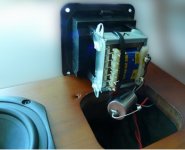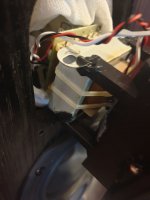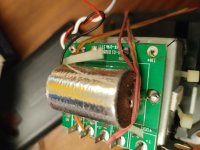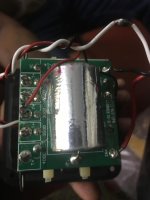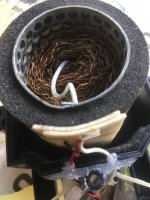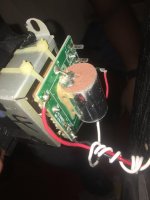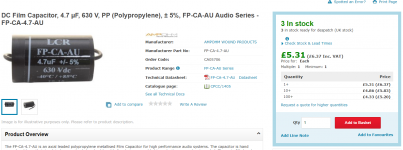Hoping the experts in here can help me. I happen to have a Gallo acoustic classico CL-4 speaker. The tweeter inside one of the speakers is not working. The cause seems to be the capacitor. No values are written on the capacitor.
Here is some mumbo jumbo I happen to find on a website regarding this capacitor.
"We again run a DC blocking capacitor on our now 180° dispersion film tweeter for amplifier protection. The quality of this cap is ultra important since it also operates as a small voltage divider on a purely capacitive driver. By the time we get to the Classico IV this part becomes a very costly TRT Stealthcap unit from Peter Moncrieff."
1) Is it possible to measure a capacitor and get values like capacitance and Vdc from it.
2) Would it be okay if I use a capacitor with the same values but from a different brand. Risky, cause it says the cap is for amp protection. The original caps cost in the line of $150 for a single one.Will it change the sound signature?
Which caps would you recommend and where can I get them. Please note the cap functions as a DC block cap and also as a small voltage divider on a purely capacitive driver.
3)I assume I need to replace capacitors on both speakers.
Valuable inputs are much appreciated. I'm new to all this as well. Pics of the capacitor and the tweeter. The tweeter is attached to a transformer which is then attached to the capacitor.
Here is some mumbo jumbo I happen to find on a website regarding this capacitor.
"We again run a DC blocking capacitor on our now 180° dispersion film tweeter for amplifier protection. The quality of this cap is ultra important since it also operates as a small voltage divider on a purely capacitive driver. By the time we get to the Classico IV this part becomes a very costly TRT Stealthcap unit from Peter Moncrieff."
1) Is it possible to measure a capacitor and get values like capacitance and Vdc from it.
2) Would it be okay if I use a capacitor with the same values but from a different brand. Risky, cause it says the cap is for amp protection. The original caps cost in the line of $150 for a single one.Will it change the sound signature?
Which caps would you recommend and where can I get them. Please note the cap functions as a DC block cap and also as a small voltage divider on a purely capacitive driver.
3)I assume I need to replace capacitors on both speakers.
Valuable inputs are much appreciated. I'm new to all this as well. Pics of the capacitor and the tweeter. The tweeter is attached to a transformer which is then attached to the capacitor.
Attachments
You can accurately measure capacitance but that assumes the part you are measuring is OK to begin with. You must measure with at least one end free and not connected to anything else.
There is no reliable way to know the working voltage of a cap by simple measurement.
The bit about it being a divider applies to any cap used in this way, its not some unique property this one possesses.
I'm not familiar with the speaker, however your images seem to show its a passive type of speaker i.e. no high voltage polarising voltage is present (which would need a mains power supply).
If that is so then I wouldn't worry over using a standard replacement.
You need to find the value as a first step.
There is no reliable way to know the working voltage of a cap by simple measurement.
The bit about it being a divider applies to any cap used in this way, its not some unique property this one possesses.
I'm not familiar with the speaker, however your images seem to show its a passive type of speaker i.e. no high voltage polarising voltage is present (which would need a mains power supply).
If that is so then I wouldn't worry over using a standard replacement.
You need to find the value as a first step.
As it is probably one of a pair, I would measure the capacitor from the good speaker, (lift one leg only).
Measure the value with a known good capacitance meter and re solder the good one.
Mooly describes the procedure accurately.
You will then have a good starting point to find a replacement.
Most are rated at either 50 or 100volts and are bi polar. Yours looks like foil type.
Measure the value with a known good capacitance meter and re solder the good one.
Mooly describes the procedure accurately.
You will then have a good starting point to find a replacement.
Most are rated at either 50 or 100volts and are bi polar. Yours looks like foil type.
Greetings tachyonmask,
There is nothing special about TRT caps. Many brands use more or less the same commodities, often the same process. There are few differences between two caps of the same technology. Main factor are capacitance and voltage values then ESL, ESR, Loss factor are important to know to acheive the same sound when swapping a cap. Dielectric rigidity of some dilectric can acheive to give a different signature for golden ears.
The closest and easiest way is too choose the same dielectric and technolohy (electrolyt, mkt, mkp, paper, foil type, etc...) of course same voltage and capacitance and look for the esr, loss factor of the genuine cap to try to find on catalogs the closest spec from the others cap brands.
As I was told in this thread I advise for the excellent given tips, when agging the ESR (ohms) increases then after a while capacitance value beginns to drift and the filter is out off its specs. It seems youn don't need refurbishing before 20 years minimum... and some partiular caps, films, never drift enough to care and are ok for a life !
In the TRT you show, not being a specialist, it looks close to a paper cap with metal foils (aluminium, copper, ZN, ???, and wax or oil). Looks like it was made maybe with a particular capacitance... or not (some speaker designers love to hyde all as it was rockett science).
I believe not being a lytic, the capacitance has certainly not drifted and ESR so few for you to notice... measure it and keep it. You may also call Gallo to know.
You can find some subjective info on TRT caps on Humblehomemadehifi caps site.
ANd look this about caps agging and measurement as well but said shortly Molly is right to say than the main challenge is to know if the cap has still the same specs than new !
Even shorter could be said :"if not a lytic, just keep it" : 40 years lytic bipolar that drifted up...
hope that helps, some caps being more expensive than gold without being an investment.
There is nothing special about TRT caps. Many brands use more or less the same commodities, often the same process. There are few differences between two caps of the same technology. Main factor are capacitance and voltage values then ESL, ESR, Loss factor are important to know to acheive the same sound when swapping a cap. Dielectric rigidity of some dilectric can acheive to give a different signature for golden ears.
The closest and easiest way is too choose the same dielectric and technolohy (electrolyt, mkt, mkp, paper, foil type, etc...) of course same voltage and capacitance and look for the esr, loss factor of the genuine cap to try to find on catalogs the closest spec from the others cap brands.
As I was told in this thread I advise for the excellent given tips, when agging the ESR (ohms) increases then after a while capacitance value beginns to drift and the filter is out off its specs. It seems youn don't need refurbishing before 20 years minimum... and some partiular caps, films, never drift enough to care and are ok for a life !
In the TRT you show, not being a specialist, it looks close to a paper cap with metal foils (aluminium, copper, ZN, ???, and wax or oil). Looks like it was made maybe with a particular capacitance... or not (some speaker designers love to hyde all as it was rockett science).
I believe not being a lytic, the capacitance has certainly not drifted and ESR so few for you to notice... measure it and keep it. You may also call Gallo to know.
You can find some subjective info on TRT caps on Humblehomemadehifi caps site.
ANd look this about caps agging and measurement as well but said shortly Molly is right to say than the main challenge is to know if the cap has still the same specs than new !
Even shorter could be said :"if not a lytic, just keep it" : 40 years lytic bipolar that drifted up...
hope that helps, some caps being more expensive than gold without being an investment.
Last edited:
Hi everyone,
I'll try checking the values of the working cap tomorrow. Based on that I will ask for recommendations for replacement caps. Thank you so much.
At first I thought the tweeter was busted and the cap was showing 4.34.. On taking it to a tech he showed me the tweeter itself was working on giving signal to it. He had bypassed the cap it seems. He said the cap must be broken even though it was showing a reading. He said sometimes caps fail when on load.
I'll try checking the values of the working cap tomorrow. Based on that I will ask for recommendations for replacement caps. Thank you so much.
At first I thought the tweeter was busted and the cap was showing 4.34.. On taking it to a tech he showed me the tweeter itself was working on giving signal to it. He had bypassed the cap it seems. He said the cap must be broken even though it was showing a reading. He said sometimes caps fail when on load.
The problem cap showed a reading of 4.34 the first time a friend checked. I thought the tweeter itself was busted. But another tech showed me that the tweeter and transformer was fine and showed me the tweeter working after bypassing the cap. So I assume the cap needs to be changed.
Will get the capacitance of the working cap from the other speaker and then try to get more details and find a replacement cap. I think it's a custom built cap for gallo acoustics which is why no markings or values are shown on it. Very secretive but problematic for customers like me.
Thank you for the informative replies everyone. Much appreciated.
Will get the capacitance of the working cap from the other speaker and then try to get more details and find a replacement cap. I think it's a custom built cap for gallo acoustics which is why no markings or values are shown on it. Very secretive but problematic for customers like me.
Thank you for the informative replies everyone. Much appreciated.
a customer IS a customer, don't hesitate to call Gallo and report here about their open minded attitude... or not !
Sure, excellent idea to check on the working unit with the same road map : friend then the tech.
Sure, excellent idea to check on the working unit with the same road map : friend then the tech.
Could you get a good shot of both sides of the cap just for my amusement?
I really think you have a poorly soldered mess of a cap that should be replaced with something better. Considering someone found the tweeter to be good and there is a connection problem with either the cap or in the general area.
I really think you have a poorly soldered mess of a cap that should be replaced with something better. Considering someone found the tweeter to be good and there is a connection problem with either the cap or in the general area.
From a review:
Power Handling: 350W undistorted amplifier power
Minimum Suggested Power: 15 watts RMS
15W RMS would be 30W peak and not 350W, or is it PMPO ??.
Perhaps 150W RMS ??
You have some funny strange speakers indeed....
I would Try a 4,7 uF / 50V MKP Cap
Power Handling: 350W undistorted amplifier power
Minimum Suggested Power: 15 watts RMS
15W RMS would be 30W peak and not 350W, or is it PMPO ??.
Perhaps 150W RMS ??
You have some funny strange speakers indeed....
I would Try a 4,7 uF / 50V MKP Cap
> 15W RMS would be 30W peak and not 350W, or is it PMPO ??.
Why are you comparing minimum to maximum?
Why are you comparing minimum to maximum?
Which type of cap would be best for DC blocking? Also which brand? The tech has got hold of the values. He said either 4.7 or 5 would do? Dunno how far he is correct.
Something like this should be ideal I would have thought.
https://cpc.farnell.com/ampohm-wound-products/fp-ca-4-7-au/capacitor-audio-4-7uf-630vdc/dp/CA05706
Whatever you get needs to be a non electrolytic (not polarised) and what we call a film type construction. There are many that fit that description. Look for a decent voltage rating, you want higher than 63V
https://uk.farnell.com/vishay/mkt1813547255/cap-4-7-f-250v-10-pet/dp/2860213?st=4.7uF film
There are also many many more in rectangular outlines.
https://cpc.farnell.com/ampohm-wound-products/fp-ca-4-7-au/capacitor-audio-4-7uf-630vdc/dp/CA05706
Whatever you get needs to be a non electrolytic (not polarised) and what we call a film type construction. There are many that fit that description. Look for a decent voltage rating, you want higher than 63V
https://uk.farnell.com/vishay/mkt1813547255/cap-4-7-f-250v-10-pet/dp/2860213?st=4.7uF film
There are also many many more in rectangular outlines.
Attachments
Hi,
Before I could give the tech my advice after reading your comments the guy went and put a 5 uf capacitor 400v (4.7 uf only needed) . Seems to be a generic one.
I happen to listen to the speakers for the past 4 hrs. I returned after a power outage to find the only one channel playing music. After a restart of the poweramp things look normal.
Could 5 uf cap cause this issue. Cause in the gallo explanation they had said the cap was for protection of the amp, dc blocking and also as a voltage divider. The amp had issues with one channel soime time back which was fixed also..
Before I could give the tech my advice after reading your comments the guy went and put a 5 uf capacitor 400v (4.7 uf only needed) . Seems to be a generic one.
I happen to listen to the speakers for the past 4 hrs. I returned after a power outage to find the only one channel playing music. After a restart of the poweramp things look normal.
Could 5 uf cap cause this issue. Cause in the gallo explanation they had said the cap was for protection of the amp, dc blocking and also as a voltage divider. The amp had issues with one channel soime time back which was fixed also..
Could you get a good shot of both sides of the cap just for my amusement?
I really think you have a poorly soldered mess of a cap that should be replaced with something better. Considering someone found the tweeter to be good and there is a connection problem with either the cap or in the general area.
Had you considered this ?
If you go for new parts you need to change either speaker caps. So a good start will be to remove the two caps for your friend to measure, check eachother concistency and see if broked or an open circuit elswhere as suggested. With the good measured values you will have to choose the closest capacitance value in the technology Mooly member is advising.
This is how the new cap looks like
Imgur: The magic of the Internet
The old one looks like this..
Imgur: The magic of the Internet
Imgur: The magic of the Internet
The old one looks like this..
Imgur: The magic of the Internet
So already measured as out of the pcbs, what are the two caps measurements ? You don't want to know as these foil caps have near zero drift noadays ? Friend's tool suffices.
If 4.7 uf nearest, I just will go for the less expensive Vishay advised, with the 10% precision you will hit around 4,7
If 4.7 uf nearest, I just will go for the less expensive Vishay advised, with the 10% precision you will hit around 4,7
Last edited:
The tech said the old ones were 4.7uf..The new ones are 5uf.. He said it should be fine. Negligible difference he said. He seemed to know what he is doing. The new caps seems to be made for some induction stove after i googled//
I'm talking about the two same caps in each of the speqkers so the old ones of the rwo speakers., the first thing is to measure both as already out of the pcb...how can we advice your tech words if you don't believe him ????
The tech has replaced the old caps( 4.7 uf) in both the speakers. Replaced them with the new 5uf ones.
- Home
- Design & Build
- Parts
- Replacement Capacitor
